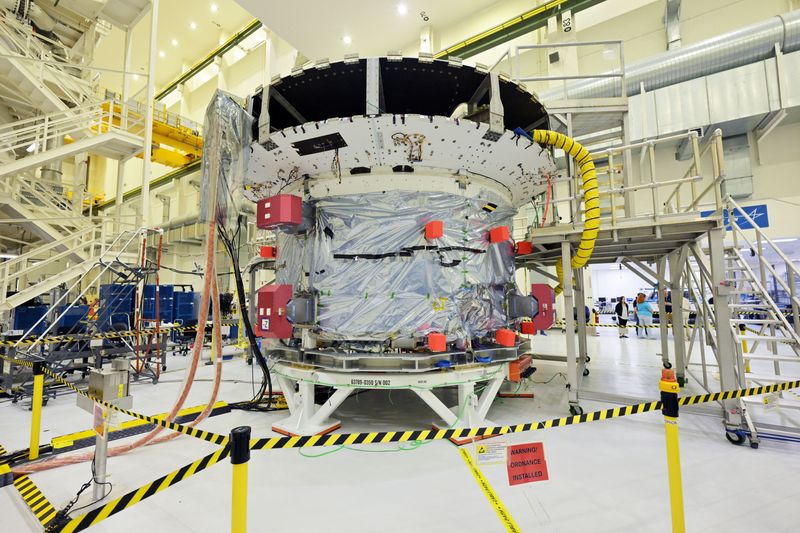NASA’s next-generation megarocket set for debut test launch to moon
2022.08.29 08:09
7/7

NASA’s Orion service module for the Artemis 2 mission stands in the Operations and Checkout Building during a media tour at Cape Canaveral, Florida, U.S. August 28, 2022. REUTERS/Steve Nesius
2/7
By Joey Roulette and Steve Gorman
CAPE CANAVERAL, Fla. (Reuters) – NASA’s colossal next-generation rocketship was set for its long-awaited debut launch on Monday on an uncrewed, six-week test flight around the moon and back, marking the first mission of the space agency’s Artemis program, successor to Apollo.
The 32-story-tall, two-stage Space Launch System (SLS) rocket and its Orion crew capsule were due for blast-off from the Kennedy Space Center in Cape Canaveral, Florida, during a two-hour launch window opening at 8:33 a.m. EDT (1233 GMT).
The maiden voyage of the SLS-Orion, a mission dubbed Artemis I, is intended to put the 5.75-million-pound vehicle through its paces in a rigorous demonstration flight, pushing its design limits, before NASA deems it reliable enough to carry astronauts.
Billed as the most powerful, complex rocket in the world, the SLS represents the biggest new vertical launch system the U.S. space agency has built since the Saturn V flown during the Apollo moon program of the 1960s and ’70s.
The spacecraft was slowly trundled to historic Launch Pad 39B earlier this month following weeks of final preparations and ground tests. Last week, NASA officials concluded their flight readiness review declaring all systems were “go for launch.”
One issue cited by NASA officials last week as a potential show stopper for Monday’s launch would be any sign during rocket fueling that a newly repaired hydrogen line fitting had failed to hold.
If the countdown clock is halted for any reason, NASA has set Sept. 2 and Sept. 5 as backup launch dates.
Barring last-minute technical difficulties or unfavorable weather, Monday’s countdown should end with the rocket’s four main R-25 engines and its twin solid-rocket boosters igniting to produce 8.8 million pounds of thrust, about 15% more thrust than produced by the Saturn V, sending the spacecraft streaking skyward.
About 90 minutes after launch, the rocket’s upper stage will thrust Orion out of Earth orbit on course for a 42-day flight that brings it to within 60 miles of the lunar surface before sailing 40,000 miles (64,374 km) beyond the moon and back to Earth. The capsule is expected to splash down in the Pacific on Oct. 10.
Although no humans will be aboard, Orion will be carrying a simulated crew of three – one male and two female mannequins – fitted with sensors to measure radiation levels and other stresses that real-life astronauts would experience.
A top objective for the mission is to test the durability of Orion’s heat shield during re-entry as it hits Earth’s atmosphere at 24,500 miles (39,429 km) per hour, or 32 times the speed of sound, on its return from lunar orbit – much faster than more common re-entries of astronaut capsules returning from low-Earth orbit.
“That’s our highest priority that we have to accomplish,” lead flight director Rick LaBrode said of demonstrating the heat shield’s ability to withstand re-entry friction, expected to raise temperatures outside the capsule to nearly 5,000 degrees Fahrenheit (2,760 Celsius). “That’s what’s going to keep the capsule together and save the astronauts.”
BACK TO THE MOON
NASA’s Artemis program – named for the goddess who was Apollo’s twin sister in ancient Greek mythology – aims to return astronauts to the moon’s surface as early as 2025, and to establish a long-term lunar colony as a stepping stone to even more ambitious future voyages sending humans to Mars.
More than a decade in development with years of delays and billions of dollars in budget overruns, the SLS-Orion spacecraft has so far cost NASA least $37 billion, including design, construction, testing and ground facilities.
NASA chief Bill Nelson has defended the Artemis program as a boon to space exploration and an “economic engine,” noting that in 2019 alone, for example, it generated $14 billion in commerce and supported 70,000 U.S. jobs.
Among the program’s greatest financial beneficiaries are the principal SLS and Orion primary contractors – Boeing (NYSE:BA) Co and Lockheed Martin Corp (NYSE:LMT), respectively.
Twelve astronauts walked on the moon during six manned Apollo missions that landed from 1969 to 1972, the only spaceflights yet to place people on the lunar surface.
If successful, Artemis I will pave the way to a first crewed SLS-Orion mission, an out-and-back flight around the moon designated Artemis II, as early as 2024, to be followed a year or more later by an Artemis III journey to the lunar surface.
Artemis III involves a much higher degree or complexity integrating the SLS-Orion with a series of spacecraft to be built and flown by Elon Musk’s launch company SpaceX.
Those include SpaceX’s own heavy-duty Starship launch and lunar-landing vehicle, still under development, as well as several components that remain to be constructed – an orbital fuel depot and space tankers to fill it. Even the new moon-walking suits remain to be designed.
NASA’s Office of Inspector General last year said that the first Artemis III lunar landing was more likely to be achieved two to three years later than the agency’s late 2025 target date.








